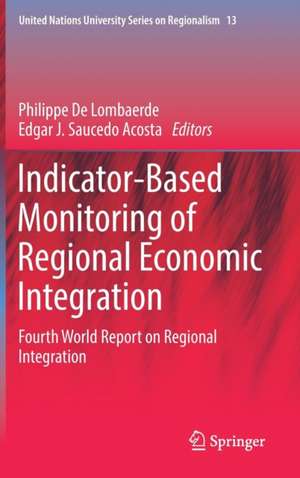Indicator-Based Monitoring of Regional Economic Integration: Fourth World Report on Regional Integration: United Nations University Series on Regionalism, cartea 13
Editat de Philippe De Lombaerde, Edgar J. Saucedo Acostaen Limba Engleză Hardback – 10 mai 2017
This volume brings together experts from different world regions. It presents various experiences with building indicator systems for monitoring the implementation of regional economic integration policies such as preferential trade areas, common markets or economic and monetary unions. The volume discusses both the technical and governance aspects of such systems, and best practices. The regional experiences that are covered include: the European Union, Eurasia, ASEAN, the East African Community (EAC), COMESA, CARICOM, the African-Caribbean-Pacific Group, and the Americas. In addition, various chapters discuss cross-cutting methodological challenges related to trade-related indicators.
Din seria United Nations University Series on Regionalism
- 15%
 Preț: 647.27 lei
Preț: 647.27 lei - 24%
 Preț: 790.70 lei
Preț: 790.70 lei - 18%
 Preț: 738.20 lei
Preț: 738.20 lei - 15%
 Preț: 645.47 lei
Preț: 645.47 lei -
 Preț: 393.35 lei
Preț: 393.35 lei -
 Preț: 395.09 lei
Preț: 395.09 lei - 15%
 Preț: 647.08 lei
Preț: 647.08 lei - 18%
 Preț: 893.05 lei
Preț: 893.05 lei - 15%
 Preț: 641.20 lei
Preț: 641.20 lei -
 Preț: 442.46 lei
Preț: 442.46 lei - 18%
 Preț: 721.81 lei
Preț: 721.81 lei -
 Preț: 425.42 lei
Preț: 425.42 lei - 15%
 Preț: 646.11 lei
Preț: 646.11 lei - 18%
 Preț: 783.68 lei
Preț: 783.68 lei - 15%
 Preț: 690.94 lei
Preț: 690.94 lei - 15%
 Preț: 691.91 lei
Preț: 691.91 lei - 18%
 Preț: 727.80 lei
Preț: 727.80 lei - 18%
 Preț: 797.24 lei
Preț: 797.24 lei - 20%
 Preț: 560.30 lei
Preț: 560.30 lei -
 Preț: 433.68 lei
Preț: 433.68 lei - 15%
 Preț: 636.12 lei
Preț: 636.12 lei - 18%
 Preț: 940.09 lei
Preț: 940.09 lei - 20%
 Preț: 577.17 lei
Preț: 577.17 lei - 15%
 Preț: 642.51 lei
Preț: 642.51 lei -
 Preț: 394.12 lei
Preț: 394.12 lei -
 Preț: 391.61 lei
Preț: 391.61 lei
Preț: 651.67 lei
Preț vechi: 766.67 lei
-15% Nou
Puncte Express: 978
Preț estimativ în valută:
124.69€ • 130.19$ • 103.20£
124.69€ • 130.19$ • 103.20£
Carte tipărită la comandă
Livrare economică 04-18 aprilie
Preluare comenzi: 021 569.72.76
Specificații
ISBN-13: 9783319508580
ISBN-10: 331950858X
Pagini: 416
Ilustrații: XXXIV, 360 p. 42 illus.
Dimensiuni: 155 x 235 x 22 mm
Greutate: 0.73 kg
Ediția:1st ed. 2017
Editura: Springer International Publishing
Colecția Springer
Seria United Nations University Series on Regionalism
Locul publicării:Cham, Switzerland
ISBN-10: 331950858X
Pagini: 416
Ilustrații: XXXIV, 360 p. 42 illus.
Dimensiuni: 155 x 235 x 22 mm
Greutate: 0.73 kg
Ediția:1st ed. 2017
Editura: Springer International Publishing
Colecția Springer
Seria United Nations University Series on Regionalism
Locul publicării:Cham, Switzerland
Cuprins
Part I: Europe and Eurasia; Chapter 1. The European Commission Internal Market Scoreboard; Vanessa Fernández Moriana, Alexandra Melissa Vida and Philippe De Lombaerde.- Chapter 2. Scoreboard for the Surveillance of Mac-roeconomic Imbalances in the European Union; Carlos Cuerpo and Jonas Fischer.- Chapter 3. The EU Index of Integration Effort; Jörg König.- Chapter 4. Integration Profiles for Central Europe and Hungary; Tibor Palankai and Gabor Miklos.- Chapter 5. The EDB System of Indicators of Eurasian Inte-gration; Evgeny Vinokurov, Alexander Libman and Vladimir Pereboyev.- Part II. The Americas and the Caribbean.- Chapter 6. Measuring Integration Achievement in the Americas; Gaspare Genna.- Chapter 7. Monitoring Re-gional Integration in Practice: Reflections from the EU-CARIFORUM Eco-nomic Partnership Agreement; Bruce Byiers and Quentin de Roquefeuil.- Chapter 8. Comparing Integration in Europe and Latin America: Wishful Thinking, Self-Perception and Reality – A Comment; Joaquín Roy.- Part III. Africa.- Chapter 9. Assessing Regional Integration in Africa (ARIA): Indica-tors of Integration Effort in Africa; Daniel Tanoe.- Chapter 10. Monitoring Regional Integration in the African, Caribbean and Pacific (ACP) Regions; Jean-Michel Salmon.- Chapter 11. The East African Community Common Market Scorecard; Alfred Ombudo K’Ombudo, Philippe De Lombaerde and Maria Borda.- Chapter 12. Assessing Regional Integration at the Country Level: A Possible Framework as Illustrated for the COMESA Region; Rattan J. Bhatia.- Part IV. Asia.- Chapter 13. Indicator-based Monitoring of Regional Economic Integration in Southeast Asia; Aladdin D. Rillo.- Part V. Methodol-ogy.- Chapter 14. Opening the Black Box of Trade Agreements; Tristan Kohl.- Chapter 15. Assessing Globalization and Regionalization through Network Indices; Lelio Iapadre and Lucia Tajoli.- Chapter 16. Measuring Actual Eco-nomic Integration: a Bayesian State-Space Approach; Glenn Rayp and Samuel Standaert.
Notă biografică
Philippe De Lombaerde is Associate Professor at NEOMA Business School, Rouen (France); and Associate Senior Research Fellow, UNU-CRIS, Bruges (Belgium). He is the former Associate Director of UNU-CRIS.
Edgar J. Saucedo Acosta is Professor of Economics, IIESES, Universidad Vera-cruzana, Xalapa (Mexico). He is also a former Visiting Researcher at UNU-CRIS, Bruges (Belgium).
Edgar J. Saucedo Acosta is Professor of Economics, IIESES, Universidad Vera-cruzana, Xalapa (Mexico). He is also a former Visiting Researcher at UNU-CRIS, Bruges (Belgium).
Textul de pe ultima copertă
This volume brings together experts from different world regions. It presents various experiences with building indicator systems for monitoring the implementation of regional economic integration policies such as preferential trade areas, common markets or economic and monetary unions. The volume discusses both the technical and governance aspects of such systems, and best practices. The regional experiences that are covered include: the European Union, Eurasia, ASEAN, the East African Community (EAC), COMESA, CARICOM, the African-Caribbean-Pacific Group, and the Americas. In addition, various chapters discuss cross-cutting methodological challenges related to trade-related indicators.
Caracteristici
The first ever systematic overview of experiences with indicator-based monitoring of regional economic integration in world regions Presents a collaborative effort of international organizations and academic experts Combines technical aspects and governance aspects of indicator-based monitoring













